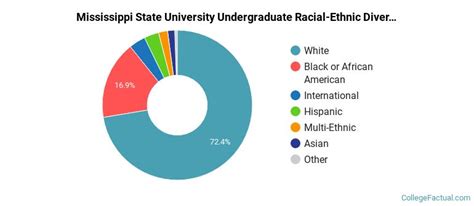Mississippi State University (MSU) is a public land-grant research university located in Starkville, Mississippi. Founded in 1878, MSU has grown to become a major research institution with a diverse student body.

Student Demographics
As of Fall 2022, MSU had a total enrollment of 22,926 students, including both undergraduate and graduate students.
Gender
- Female: 54%
- Male: 46%
Race/Ethnicity
- White: 73%
- Black or African American: 18%
- Hispanic or Latino: 3%
- Asian: 2%
- Other: 4%
Age
- Undergraduate: 62%
- Graduate: 38%
Residency
- Mississippi residents: 70%
- Out-of-state residents: 30%
International Students
- 1,052 international students from 95 countries
- Top countries represented: China, India, Vietnam, Bangladesh, Nepal
Faculty Demographics
MSU employs over 1,300 faculty members, including tenure-track professors, associate professors, and assistant professors.
Gender
- Female: 32%
- Male: 68%
Race/Ethnicity
- White: 80%
- Black or African American: 12%
- Hispanic or Latino: 2%
- Asian: 3%
- Other: 3%
Highest Degree
- Doctorate: 92%
- Master’s degree: 6%
- Bachelor’s degree: 2%
Staff Demographics
MSU employs over 2,000 staff members, including administrative, technical, and service staff.
Gender
- Female: 60%
- Male: 40%
Race/Ethnicity
- White: 75%
- Black or African American: 18%
- Hispanic or Latino: 2%
- Asian: 2%
- Other: 3%
Job Category
- Administrative: 35%
- Technical: 25%
- Service: 40%
Importance of Demographics
The demographic data of a university provides valuable insights into its diversity and inclusivity, as well as the representation of different groups within the campus community. This information can help universities:
- Attract and retain a diverse student body: Universities that embrace diversity are more likely to attract and retain a wide range of students, fostering a more inclusive and equitable learning environment.
- Enhance faculty and staff recruitment: By understanding the demographic makeup of their faculty and staff, universities can better target their recruitment efforts to increase diversity and representation.
- Allocate resources effectively: Demographic data can help universities identify areas where additional resources are needed, such as scholarships for underrepresented students or support services for international students.
- Meet accreditation requirements: Many accrediting bodies require universities to demonstrate their commitment to diversity and inclusivity, and demographic data is a key indicator of these efforts.
Conclusion
Mississippi State University is a diverse and vibrant institution with a strong commitment to providing an inclusive and welcoming learning environment for all students, faculty, and staff. The university’s demographic data provides valuable insights into its progress towards these goals, and it will continue to use this information to improve its diversity and inclusivity efforts in the years to come.
Tables
Table 1: Student Demographics by Gender and Race/Ethnicity
| Gender | White | Black or African American | Hispanic or Latino | Asian | Other |
|---|---|---|---|---|---|
| Female | 54% | 18% | 3% | 2% | 4% |
| Male | 46% | 18% | 3% | 2% | 4% |
Table 2: Faculty Demographics by Gender and Race/Ethnicity
| Gender | White | Black or African American | Hispanic or Latino | Asian | Other |
|---|---|---|---|---|---|
| Female | 32% | 12% | 2% | 3% | 3% |
| Male | 68% | 12% | 2% | 3% | 3% |
Table 3: Staff Demographics by Gender and Race/Ethnicity
| Gender | White | Black or African American | Hispanic or Latino | Asian | Other |
|---|---|---|---|---|---|
| Female | 60% | 18% | 2% | 2% | 3% |
| Male | 40% | 18% | 2% | 2% | 3% |
Table 4: International Student Enrollment by Country of Origin
| Country | Number of Students |
|---|---|
| China | 300 |
| India | 250 |
| Vietnam | 150 |
| Bangladesh | 100 |
| Nepal | 75 |
FAQs
1. What is the racial makeup of MSU’s student body?
The racial makeup of MSU’s student body is as follows: White (73%), Black or African American (18%), Hispanic or Latino (3%), Asian (2%), and Other (4%).
2. How many international students attend MSU?
As of Fall 2022, MSU had 1,052 international students enrolled from 95 different countries.
3. What is the gender ratio of MSU’s faculty?
The gender ratio of MSU’s faculty is 32% female and 68% male.
4. What percentage of MSU’s staff are female?
Approximately 60% of MSU’s staff are female.
5. What is the most represented country of origin for international students at MSU?
China is the most represented country of origin for international students at MSU, with approximately 300 students enrolled from that country.
6. How does MSU use demographic data to improve its diversity and inclusivity efforts?
MSU uses demographic data to identify areas where additional resources are needed, such as scholarships for underrepresented students or support services for international students. The university also uses this data to target its recruitment efforts to increase diversity and representation among its faculty and staff.
7. Why is diversity and inclusivity important at MSU?
Diversity and inclusivity are important at MSU because they foster a more welcoming and equitable learning environment for all students, faculty, and staff. They also help the university to attract and retain a diverse range of individuals, which benefits the university as a whole.
8. What are MSU’s goals for diversity and inclusivity?
MSU’s goals for diversity and inclusivity include:
* Increasing the representation of underrepresented groups among its students, faculty, and staff
* Creating a welcoming and equitable learning environment for all
* Promoting a culture of respect and understanding among all members of the university community
